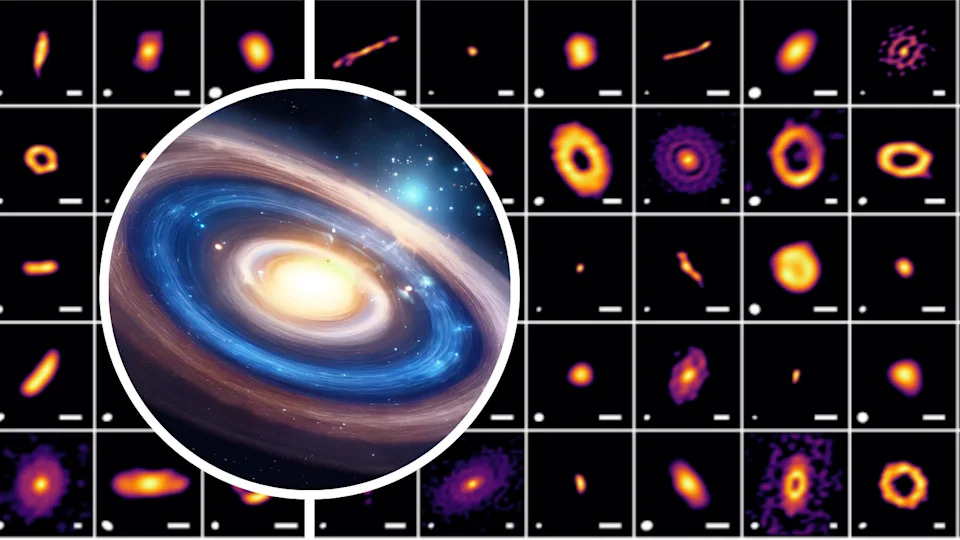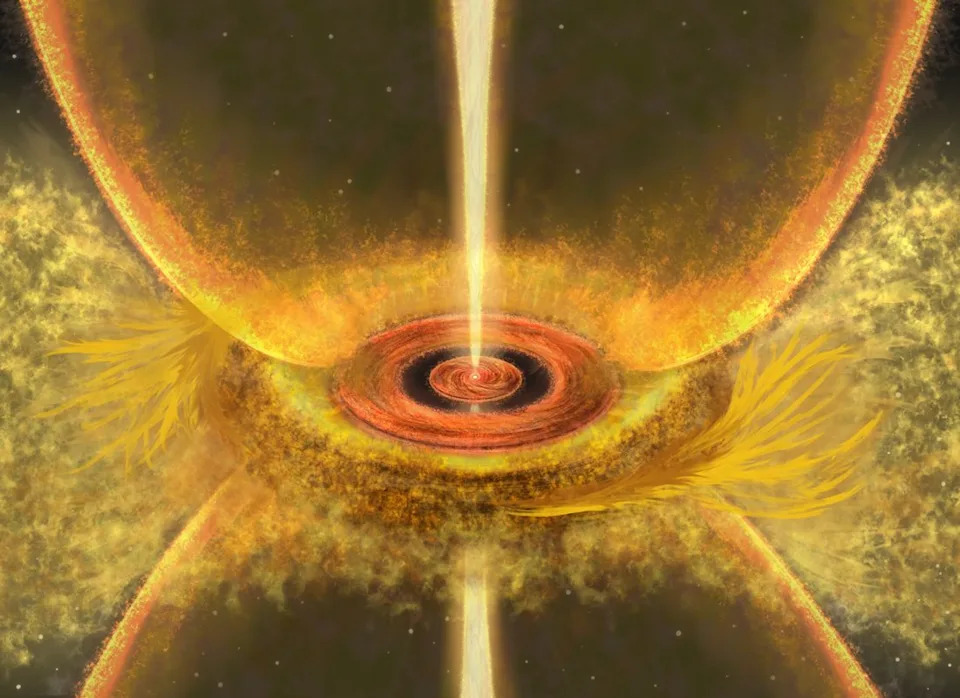Astronomers discover baby planets taking their 1st steps in nearby stellar nursery (images)
When you buy through links on our articles, Future and its syndication partners may earn a commission.
 (Main) Images of protoplanetary disks in the Ophiuchus star-forming region. (Inset) An illustration of a planet birthing-disk around a young star. | Credit: ALMA(ESO/NAOJ/NRAO), A. Shoshi et al/ Robert Lea (created with Canva)
(Main) Images of protoplanetary disks in the Ophiuchus star-forming region. (Inset) An illustration of a planet birthing-disk around a young star. | Credit: ALMA(ESO/NAOJ/NRAO), A. Shoshi et al/ Robert Lea (created with Canva)Astronomers may have caught the first stages of planets being born around infant stars.
The discovery came about when a team of scientists studied 78 planet-forming, flattened clouds of gas and dust, or "protoplanetary disks," in the Ophiuchus star-forming region. This stellar nursery, also known as the Rho Ophiuchi cloud complex, is located around 460 light-years from Earth, making it the closest star-forming region to our solar system.
The team discovered previously unseen rings, spirals and other substructures in the swirling, plate-like planet-forming clouds around a number of stars just a few hundred thousand years old. If that seems ancient, consider this: Our middle-aged star, the sun, is 4.6 billion years old.
The team's findings suggest stars and planets evolve together in environments that are rich in gas and dust.
Investigating the co-evolution of planets and stars
Stars are born when overly dense regions in vast clouds of gas and dust called molecular clouds collapse under their own gravity. This collapse creates a protostar wrapped in a pre-natal envelope of material from which it continues to gather mass. This matter-harvesting continues until the star is sufficiently massive enough to trigger the fusion of hydrogen to helium at the heart of the star, the nuclear process that defines what a fully grown or main-sequence star is.The end result is a young star surrounded by a flattened disk of gas and dust within which planets can begin to form. When planets begin to take shape in these disks, their gravitational influence can gather or eject materials. That process gives rise to substructures in the protoplanetary disk.
However, the big question is: At what point in the evolution of planetary systems do these substructures begin to appear?
 A comparison of images of protoplanetary disks in the Ophiuchus star-forming region, created with super-resolution imaging with sparse modeling versus conventional imaging method. The evolution stage of the central stars progresses from left to right, and from top to bottom in the same row. | Credit: ALMA(ESO/NAOJ/NRAO), A. Shoshi et al.
A comparison of images of protoplanetary disks in the Ophiuchus star-forming region, created with super-resolution imaging with sparse modeling versus conventional imaging method. The evolution stage of the central stars progresses from left to right, and from top to bottom in the same row. | Credit: ALMA(ESO/NAOJ/NRAO), A. Shoshi et al.That's a question astronomers have been attempting to answer using the Atacama Large Millimeter/submillimeter Array (ALMA), an array of 66 antennas in northern Chile that work together to act as form a single telescope.
In particular, two large programs conducted by ALMA, DSHARP and eDisk, have discovered intricate details of structures in protoplanetary disks.
DSHARP found that such structures are common in the disks that surround 20 young stars under 1 million years of age. Meanwhile, eDisk studied younger protostars that are just between 10,000 and 100,000 years old and thus still in their matter-harvesting stage. This revealed that structures present around 1 million-year-old stars are absent around stars 10 and 100 times younger.
That implies the characteristics of a protoplanetary disk are dependent on the age of its central star.
 An illustration of substructures forming in a protoplanetary disk. | Credit: Y. Nakamura, A. Shoshi et al.
An illustration of substructures forming in a protoplanetary disk. | Credit: Y. Nakamura, A. Shoshi et al.The new study's team looked at stars with ages between those studied in the DSHARP and eDisk programs, turning to super-resolution imaging provided by public software called "Python module for Radio Interferometry Imaging with Sparse Modeling," or (PRIISM), and applied this to ALMA archival data.
This allowed the researchers to obtain a resolution three times greater than what's provided by standard procedures for half of the imaged protoplanetary disks. The team's results were further bolstered by the fact their Ophiuchus sample was four times larger than what was used in the DSHARP and eDisk programs.
The investigation revealed 27 of the 78 examined disks had ring or spiral structures, 15 of which had never been seen before.
This revealed substructures form in disks that have widths 30 times the distance between Earth and the sun (30 astronomical units). This, in turn, implies that substructures form much earlier than previously thought — while such disks are still abundant with gas and dust.
In other words, infant stars and planets seem to evolve together — at least, in the Ophiuchus stellar nursery.
Related Stories:
—The deadly atmosphere on Venus could help us find habitable worlds. Here's how.
— Could nearby stars have habitable exoplanets? NASA's Chandra X-ray Observatory hopes to find out
— Astronomers discover origins of mysterious double hot Jupiter exoplanets: 'It is a dance of sorts'
"These findings, bridging the gap between the eDisk and DSHARP projects, were enabled by the innovative imaging that allows for both achieving high resolution and a large number of samples," Ayumu Shoshi, team leader and a researcher at Kyushu University, said in a statement. "While these findings only pertain to the disks in Ophiuchus, future studies of other star-forming regions will reveal whether this tendency is universal."
The team's research was published in The Publications of the Astronomical Society of Japan
A captivating glimpse into the birthplaces of planets, this groundbreaking discovery by astronomers unveils baby worlds in their tentative strides within our nearby cosmic nursery. The images are a testament to humanity's ongoing exploration and understanding - we have never been closer than now.
This groundbreaking discovery of baby planets taking their first steps in a nearby stellar nursery offers remarkable insights into the early stages of planetary formation and evolution, offering hope for interstellar exploration.














